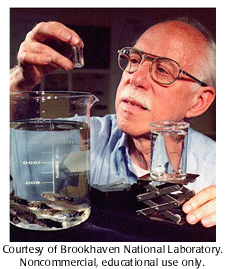சில வகையான பிறழ்வுகள் தானாகவே சீர்திருத்தப்படும்.

 Claud Rupert did seminal research on light-activated DNA repair systems. Richard Setlow did a lot of the early work on thymine dimer repair.
Claud Rupert did seminal research on light-activated DNA repair systems. Richard Setlow did a lot of the early work on thymine dimer repair.
- Go to:
- Claud S. Rupert (1919-)
Richard B. Setlow (1921-)

Richard Setlow was born in 1921 and grew up in the Bronx. Good grades in school qualified him for entrance into the Townsend Harris High School, which was later closed down by Mayor LaGuardia for elitism. He went to Swarthmore College with an interest in science and encountered an exceptional physics instructor. "So I became a physicist because you could explain things so beautifully," Setlow says.
After graduating from college in 1941, Setlow went to Yale to continue his study of physics. "There was a biophysics group being started in the physics department, and I thought that would be a lot of fun," Setlow recalls. "We spent a lot of time irradiating proteins and viruses and cells with ionizing radiation and with ultraviolet radiation."
Setlow received his Ph.D. in physics in 1947 and continued teaching physics and biophysics at Yale until 1961 when he left for the Oak Ridge National Laboratory because he "wanted to have more time for research because it was so much fun."
He first became interested in DNA repair mechanisms when someone at Oak Ridge asked him, " 'Hey Dick, what do you know about these crazy Dutchmen that are irradiating frozen solutions of thymine', and I had to confess I didn't know anything."
After researching the papers of the crazy Dutchmen, Setlow decided their conclusion -- that the thymine dimers they broke with UV irradiation was the same as cellular photoreactivation -- was wrong and set out to solve the problem. In 1964, he and his colleagues showed that bacterial cells repair thymine dimers with enzymes that remove the dimer and replace it with undamaged bases.
In 1974, Setlow moved to the Brookhaven National Laboratory(BNL) where he is still active in DNA repair and ultraviolet radiation research. In the 1990s, using a special hybrid fish sensitive to ultraviolet light, Setlow's team found that UV-A rays cause most melanomas, not UV-B rays that were previously thought responsible.
Because of his finding, Setlow thinks the large increase in melanoma incidence is not due to a thinning ozone layer, which only filters out UV-B rays. "My feeling is that the big increase in malignant melonoma comes about because of lifestyle changes," he says. People use sunblock to stay out longer in the sun, but sunblocks — even those that claim to block UV-A — "do not screen out the wavelengths that are probably inducing melanoma."
In 1998, Setlow retired from his administrative duties at BNL as the Associate Director for Life Sciences to devote more time to his research. Setlow also enjoys music, hiking, and volunteering at a camp for handicapped persons.
Among his many awards, Setlow was elected to the National Academy of Sciences in 1973, and became a Fellow of the American Association for the Advancement of Science in 1988.


DNA repair enzymes were collectively honored as 1994's "Molecule of the Year" by Science magazine.

Your DNA repair mechanisms can not keep up with damage caused by overexposure to the sun. Does your sunscreen protect you from cancer-causing UV-A rays?
 உட்கருவின் முக்கிய மூலக்கூறுகள் டிஎன்ஏ மற்றும் புரதங்களாகும்.
உட்கருவின் முக்கிய மூலக்கூறுகள் டிஎன்ஏ மற்றும் புரதங்களாகும். ஒரு மரபணு ஒரு புரதத்தை உருவாக்குகிறது.
ஒரு மரபணு ஒரு புரதத்தை உருவாக்குகிறது. ஒரு மரபணு டிஎன்ஏ' வால் ஆனது.
ஒரு மரபணு டிஎன்ஏ' வால் ஆனது. பாக்டீரியா மற்றும் வைரஸ்களிலும் டிஎன்ஏ'கள் உள்ளன.
பாக்டீரியா மற்றும் வைரஸ்களிலும் டிஎன்ஏ'கள் உள்ளன. டிஎன்ஏ-மூலக்கூறு, முறுக்கப்பட்ட ஏணி போன்று வடிவமைக்கப்பட்டுள்ளது.
டிஎன்ஏ-மூலக்கூறு, முறுக்கப்பட்ட ஏணி போன்று வடிவமைக்கப்பட்டுள்ளது. டிஎன்ஏ ஏணியின் ஒரு பாதி மற்றொன்றுக்கு வார்ப்புருவாகும்.
டிஎன்ஏ ஏணியின் ஒரு பாதி மற்றொன்றுக்கு வார்ப்புருவாகும்.  ஆர்என்ஏ'வானது, டிஎன்ஏ' மற்றும் புரதத்திற்கு இடையே ஓர் பாலமாக உள்ளது.
ஆர்என்ஏ'வானது, டிஎன்ஏ' மற்றும் புரதத்திற்கு இடையே ஓர் பாலமாக உள்ளது. டிஎன்ஏ'யின் வார்த்தைகள் மூன்று எழுத்துகளால் ஆனவையாகும்.
டிஎன்ஏ'யின் வார்த்தைகள் மூன்று எழுத்துகளால் ஆனவையாகும். டிஎன்ஏ நியூக்ளியோடைட்களின் வரிசையே மரபணுவாகும்.
டிஎன்ஏ நியூக்ளியோடைட்களின் வரிசையே மரபணுவாகும். ஆர்என்ஏ தகவல்கள் சில நேரங்களில் திருத்தியமைக்கப்படுகின்றன.
ஆர்என்ஏ தகவல்கள் சில நேரங்களில் திருத்தியமைக்கப்படுகின்றன. சில வைரஸ்கள் மரபணு தகவல்களை ஆர்என்ஏ'வில் சேமிக்கும்.
சில வைரஸ்கள் மரபணு தகவல்களை ஆர்என்ஏ'வில் சேமிக்கும். ஆர்என்ஏ'களே முதலிலெழுந்த மரபணு மூலக்கூறுகளாகும்.
ஆர்என்ஏ'களே முதலிலெழுந்த மரபணு மூலக்கூறுகளாகும்.  பிறழ்வுகளானவை, மரபணு தகவல்களின் மாற்றங்களாகும்.
பிறழ்வுகளானவை, மரபணு தகவல்களின் மாற்றங்களாகும்.  சில வகையான பிறழ்வுகள் தானாகவே சீர்திருத்தப்படும்.
சில வகையான பிறழ்வுகள் தானாகவே சீர்திருத்தப்படும்.